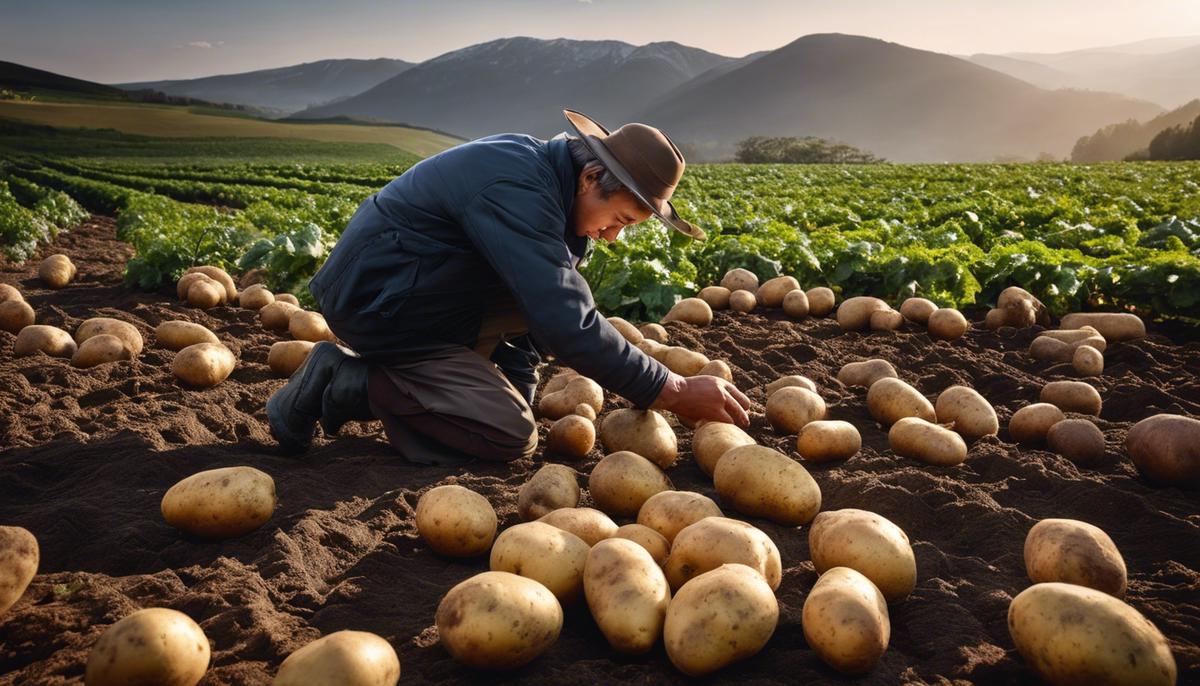Sprout Perfect Potatoes: An Easy Guide

Sprouting your own potatoes is not only a fascinating process to observe, but also a great way to ensure that the produce you consume is organic and grown locally. In the pursuit of this green endeavor, the first step holds significant importance – selecting the right type of potato suitable for your geographic location. This decision dictates how your potato sprouts and grows. Hence, throughout this guide, we provide you with comprehensive detail about various potato types best suited for sprouting, and the distinct characteristics to look for. Moreover, we delve into the preparation and sprouting process which, while elemental, mandates careful execution. We guide you through the steps of wisely cutting the potato, ensuring each piece contains a sprouting point, properly drying it out, and then initiating the sprouting process. Finally, we explore the optimal growing conditions that potatoes need to sprout successfully, discussing the ideal sunlight exposure, temperature settings, soil types, and watering routines to follow.
Selecting the Right Potato
The Path to Perfect Potato Sprouts: Choose Your Spuds Wisely!
How enchanting! The sprouting wonder of potato tubers fashioned into something equally wonderful and beautiful. The hobby of sprouting potatoes is something that all green thumbs, novice or veteran, can find a profound joy in. So, let’s get right into it: which potatoes are the ideal choice for sprouting, you wonder? You’ve got all that excitement and energy, and it’s our pleasure to steer you in the right direction!
- Organic Potatoes: Top of the Crop!
- Russet Potatoes: The Household Name!
- Yukon Gold Potatoes: A Keen Grower’s Goldmine!
- Fingerling Potatoes: The Small Wonders!
- Red and Purple Potatoes: Add a Splash of Color!
- Heirloom Varieties: Tried and True!
Excited about sprouting your own potatoes? Start with organic potatoes! They remain free from any sprout-inhibiting chemicals typically found in the conventionally grown brethren of these tubers. Organic potatoes are a sure-shot win when you’re looking to sprout some sturdy and healthy new plants.
A universally recognized staple in the world of potatoes, Russets have a hard-to-match versatility, making them the pick of the litter when it comes to sprouting. Hearty, full-sized sprouts can be expected when planting whole or cut-up seed potatoes.
Yukon Gold potatoes have the Midas touch for sprouting hobbyists. These yellow-fleshed beauties are well-suited to produce consistent sprouts. Moreover, they are known for their adaptability; suitable for varying climate conditions.
Don’t let their size fool you! Fingerlings may be small in proportion, but when it comes to sprouting, they stand tall. Equipped with excellent hilling properties, these tiny tubers are far more likely to produce long-lasting, strong sprouts.
Sprouting need not be just about those earthy tones, why not add a bit of vibrancy to the mix? Red and purple potatoes are delightful choices for sprouting, with their colorful appeal and quality sprouts adding a vibrant kick to any garden.
For those who appreciate time-honored tradition, Heirloom potato varieties also make a fantastic option for sprouting. With their rich history, varying shapes and diverse coloring, they are an absolute treasure to sprout.
Learning about the art of potato sprouting is a journey full of fun-filled discoveries. Keep in mind, the success rate can greatly increase by choosing certified disease-free seed potatoes, which are guaranteed to give you a healthy head-start. Whether you wish to create a cultivation marvel or simply indulge in a relaxing metaphor for growth, selecting the appropriate potatoes for sprouting is the first important step in crafting your own tuberous oasis. Happy planting!

Preparing and Sprouting the Potato
Choosing Your Spud: The Great Unveiling!
The potato, Solanum tuberosum if we’re getting scientific, is a resilient veggie, fit for sprouting. It deserves careful selection for the top-notch yield that all of us spud enthusiasts eagerly await. The trick is to choose wisely; opt for a tuber that’s mature, firm, and sports a few ‘eyes’. Those little bumps are not just potatoes’ way of keeping an eye on you; it’s where the magic begins, and the new plant sprouts.
Preparing Like Pro: The Elemental Ecosystem!
After your grand selection, the real preparation begins! Ensure that your chosen potato is nice and clean for its upcoming transformation. A light scrub under fresh, cool water removes any lingering soil or debris – don’t forget those crevices! Once cleaned, the tuber takes a grand tour of your most well-lit room, basking under indirect sunlight for 5 to 7 days or until the skin toughens. A touch of callus helps protect from rot whilst providing a sturdy base for your eager little sprouts.
The Grand Sprouting: Embrace the Excitement!
Now that your potato is gazing at life through toughened eyes, it’s sprouting time! Some may tell tales of the need to cut your potato into pieces, each with an eye or two. However, this enthusiastic hobbyist suggests a whole potato approach. Why, you ask? The whole potato is laden with nutrients essential to get a hearty plant, especially for those first critical weeks.
Dig a hole around four inches deep and gently settle your ready-to-bloom buddy, eyes facing upwards – they are about to seek the sunlight, after all! Carefully cover it with a mix of compost and soil but remember not to pack it down too tightly. Those tiny shoots require space and air to spread their leafy wings.
Living the Spud Life: Onwards and Upwards!
For these next few weeks, patience is your best friend. Gradually, ethereal green shoots reach out for sunlight and start the life of your very own potato plant. The mantra for this stage: regular watering (but not saturating!), good drainage, and a dash of love. Observe your plant companion; adjust your care routine as needed. Strive for the Goldilocks regime – not too wet not too dry, just perfect.
Celebrating Growth: Begin the Countdown!
Over the period of 70 to 120 days, what was once a humble spud transforms into a flourishing plant. All that’s left is for you to sit back, marvel at the magical transformation, and count the days until harvest. But! That is the thrill of another tale. Until then, enjoy the journey – for this is the wondrous world of potato sprouting!

Photo by ellaolsson on Unsplash
Optimal Growing Conditions
Unearthing the Magic of Sprouting Conditions
The humble potato in your home can soon flourish into a hearty crop, given the right conditions! Taking the reins after the selection, cleaning, and prepping of your potatoes, here’s a glimpse into creating the perfect environment for hearty sprouting.
The spring season, with its moderate temperatures and lengthening daylight hours, is the optimum time to embark on the potato-sprouting journey. Warm soil, ideally hovering between 45-85°F (7-29°C), serves as a wholesome cradle for these tubers. Want to kickstart your growing season? In such cases, indoor sprouting, also known as ‘chitting,’ becomes your best bet!
Pre-sprouting indoors should reach your bucket list if you’re a fan of early yields! Begin this process 4-6 weeks prior to the outdoor planting date. Using room temperature conditions, place potatoes in egg cartons or specialized seed trays— with eyes facing up!
Sublime sunshine goes a long way in potato sprouting. This isn’t to say you cultivate a mini-sun indoors, but a bright, cool room works wonders. Warm temperatures accelerate sprouting, while cooler climes lend to slow, sturdy growth. Try fixating your sprouts near a window with indirect light, as potatoes aren’t huge fans of direct sunlight.
Just like us following a satisfying meal, potatoes, too, like a good soak-up followed by drying. Imbue this in your watering regimen. Keep soil moist but ensure excellent drainage to prevent water clogging— nothing annoys a potato more than waterlogged surroundings.
One cardinal rule in potato sprouting is the eye’s position. Plant potatoes with sprouted ‘eyes’ facing upwards. They’re the plant’s advent to surface life, and this upward facing aids the shoot’s emergence.
A crucial aspect of potato sprouting involves the fertile, well-drained, slightly acidic soil with a pH from 5.0 to 7.0. You could get hands-on with compost, well-rotted manure, or a blend of balanced vegetable organic fertilisers to fortify soil fertility. This vastly influences their later stages as they metamorphose from tiny sprouts to delicious tubers.
What could be more exciting than watching potatoes bloom into healthy plants with pretty white flowers? The length of this sprouting phase varies, essentially lying between 70 to 120 days. Once your sprouts attain a good 6 to 8 inches in height— voila! It’s time to think about layering soil.
In the end, while we don’t advocate helicoptering over sprouting potatoes, checking in on their progress from time-to-time won’t hurt. This gentle vigil not only aids immediate corrective measures but also solidifies your bond with these tenacious tubers. There’s a magic in watching a speck of life sprout into something that makes our meals memorable— and that’s the joy of potato sprouting. Here’s to successful sprouting endeavours!

Getting a potato to sprout is somewhat an art that requires a systematic approach and patience. By selecting the right potato type, preparing it with care, and providing it with ideal growing conditions, your green venture can result in flourishing potato sprouts. Your awareness about the different potato types, their suitability to your local geography, and their sprouting tendencies can make all the difference in your success. Additionally, understanding all steps of the preparation and sprouting process can refine your skills to ensure each potato chunk sprouts beautifully. Lastly, following the guidelines for optimizing growing conditions can help your potatoes thrive and sprout with vigour. So equip yourself with the knowledge, take on the adventure of growing your own potatoes, and reap the rewards of your gardening prowess.



